GIGABYTE Server MD60-SC0 Motherboard Review: Haswell-EP with QSFP
by Ian Cutress on December 3, 2014 10:00 AM ESTProfessional Performance
Professional Performance: Windows
Agisoft Photoscan – 2D to 3D Image Manipulation: link
Agisoft Photoscan creates 3D models from 2D images, a process which is very computationally expensive. The algorithm is split into four distinct phases, and different phases of the model reconstruction require either fast memory, fast IPC, more cores, or even OpenCL compute devices to hand. Agisoft supplied us with a special version of the software to script the process, where we take 50 images of a stately home and convert it into a medium quality model. This benchmark typically takes around 15-20 minutes on a high end PC on the CPU alone, with GPUs reducing the time.
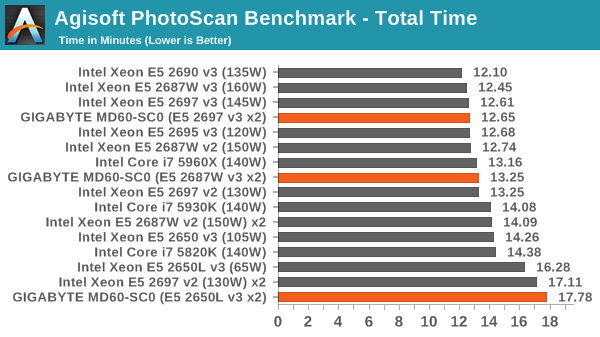
Cinebench R15
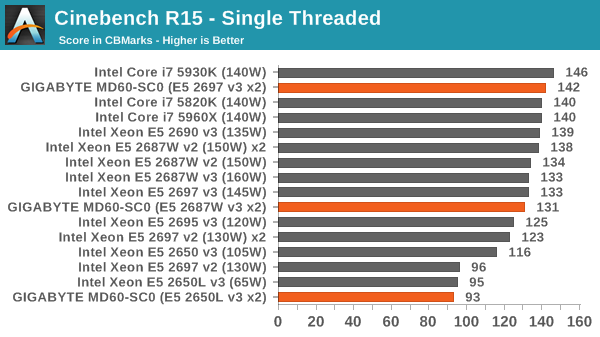
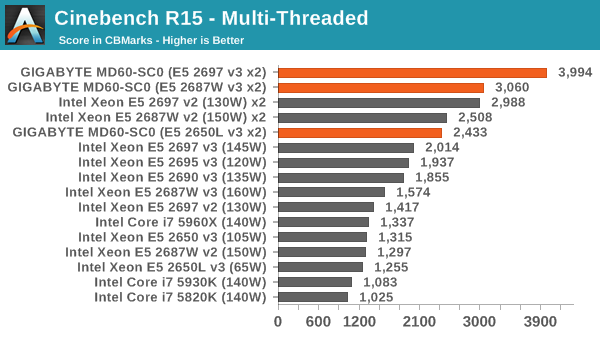
Professional Performance: Linux
Built around several freely available benchmarks for Linux, Linux-Bench is a project spearheaded by Patrick at ServeTheHome to streamline about a dozen of these tests in a single neat package run via a set of three commands using an Ubuntu 14.04 LiveCD. These tests include fluid dynamics used by NASA, ray-tracing, molecular modeling, and a scalable data structure server for web deployments. We run Linux-Bench and have chosen to report a select few of the tests that rely on CPU and DRAM speed.
C-Ray: link
C-Ray is a simple ray-tracing program that focuses almost exclusively on processor performance rather than DRAM access. The test in Linux-Bench renders a heavy complex scene offering a large scalable scenario.
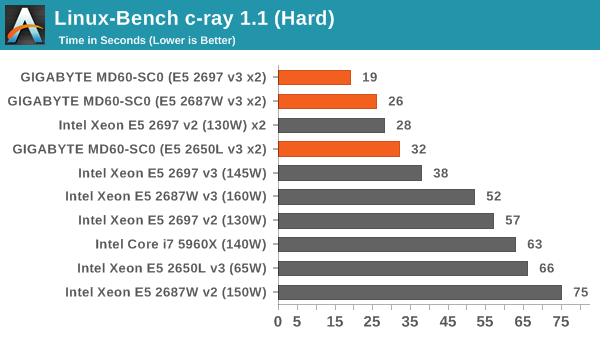
NAMD, Scalable Molecular Dynamics: link
Developed by the Theoretical and Computational Biophysics Group at the University of Illinois at Urbana-Champaign, NAMD is a set of parallel molecular dynamics codes for extreme parallelization up to and beyond 200,000 cores. The reference paper detailing NAMD has over 4000 citations, and our testing runs a small simulation where the calculation steps per unit time is the output vector.
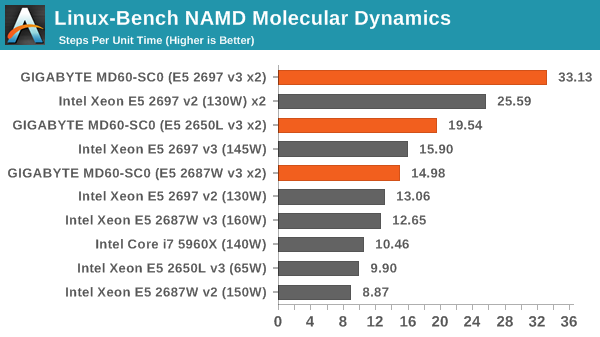
NPB, Fluid Dynamics: link
Aside from LINPACK, there are many other ways to benchmark supercomputers in terms of how effective they are for various types of mathematical processes. The NAS Parallel Benchmarks (NPB) are a set of small programs originally designed for NASA to test their supercomputers in terms of fluid dynamics simulations, useful for airflow reactions and design.
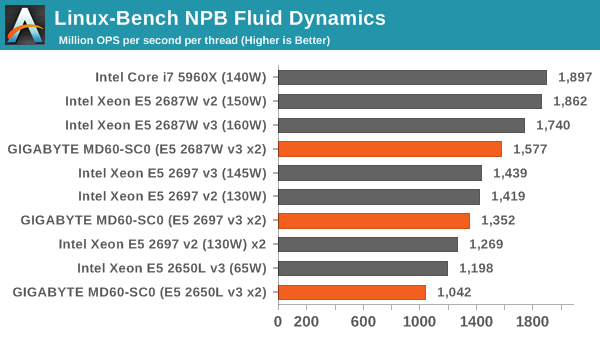
Redis: link
Many of the online applications rely on key-value caches and data structure servers to operate. Redis is an open-source, scalable web technology with a b developer base, but also relies heavily on memory bandwidth as well as CPU performance.
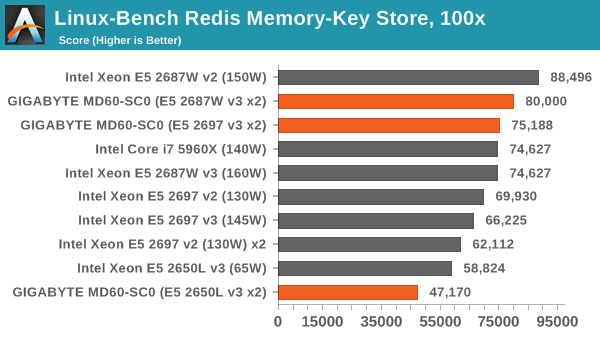
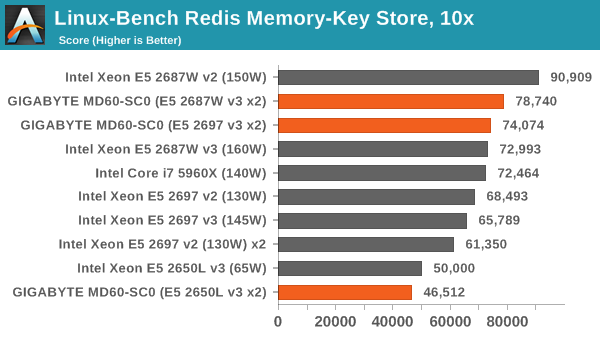
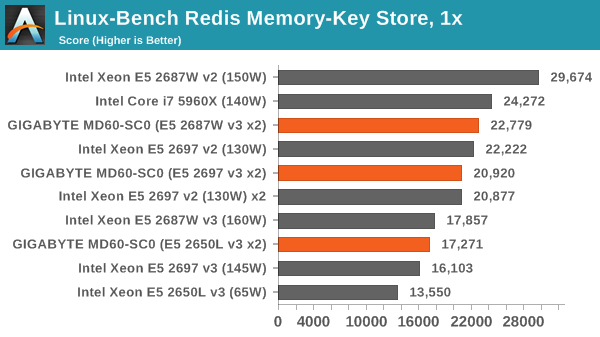










17 Comments
View All Comments
PCTC2 - Wednesday, December 3, 2014 - link
Coming from the HPC space, seeing 512GB-1TB of RAM was pretty regular, but seeing 1.5TB-2TB was rare, but did occur. However, now with systems being able to have 6TB of RAM in a single 4U rack server is pretty incredible (4P servers with 96 DIMMs, Intel E7 v2 support).However, there are a few odd things about this board. For one, the QSFP+ is totally unnecessary, as it only supports 2x10GbE, and is not either 1) Infiniband or 2) 40GbE. Sure, with LACP, you could have bonded 20GbE, but you either need a splitter cable (QSFP+ to 4x SFP, with 2 SFP unusable) or a switch that supports multiple links over QSFP+ (a 40GbE with 10GbE breakout capabilities). Also, the decision to use the SFF-8087 connectors for the SATA and individual ports for SAS confounds me, as you lose the sideband support with individual cables, and onboard SATA doesn't support the sideband, thus losing some functionality with some backplanes. Also, the card Gigabyte advertises with this board is an LSI 2308, an HBA and not a full hardware RAID.
Some of Gigabyte's B2B systems have intrigued me, especially their 8x Tesla/Phi system in 2U, but this board just doesn't seem completely thought out.
jhh - Wednesday, December 3, 2014 - link
I suspect the QSFP was designed to support a Fortville, but they didn't get them qualified in time. That would get them a true 40 Gig port, or 4x10Gfackamato - Friday, December 5, 2014 - link
What's fortville?Cstefan - Friday, December 5, 2014 - link
Intel 40GBE QSFP+Nothing the consumer need worry over for a long time yet.
Klimax - Sunday, December 7, 2014 - link
With some results already available:http://www.tweaktown.com/reviews/6857/supermicro-a...
Cstefan - Friday, December 5, 2014 - link
I run multiple database servers with 2TB of ram. My next round is slated for 4TB. And absolutely no joke, they reversed the SAS and SATA connectors in a monumentally stupid move.ddriver - Wednesday, December 3, 2014 - link
Well, surprisingly no gaming benchmarks this time, but what's with the "professional performance" benches? How many professionals out there make their money on running cinebench? How about some real workstation workloads for a change?JeffFlanagan - Wednesday, December 3, 2014 - link
This isn't a workstation, or a gaming machine.ddriver - Wednesday, December 3, 2014 - link
I actually applauded the absence of gaming benchmarks this time. As for whether this is for a workstation machines, I'd say it is far more suited for a workstation than suited for running winrar and image viewing software.And just to note this "review" of a "serve" motherboard doesn't have a single server benchmark whatsoever...
mpbrede - Wednesday, December 3, 2014 - link
My usual gripe about acronyms that are not accompanied by an explanation when the term is first used. THis time aggravated by a typo, I'm sure."The system is based on the C612 chipset, which is similar to the consumer based X99 but with 2P related features, such as MTCP over PCIe."
I'm pretty sure you meant to type MCTP (Management Component Transport Protocol) and not the mTCP (microTCP?) or MTCP (Malaysian Technical Cooperation Programme or has something to do with Transport Layer Support for Highly Available Network
Services)